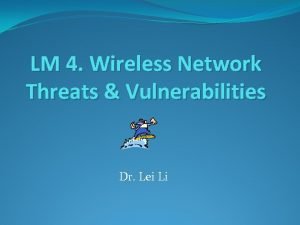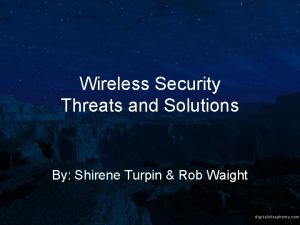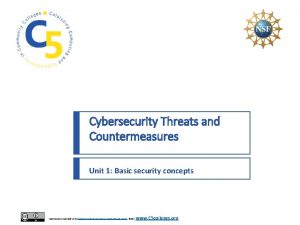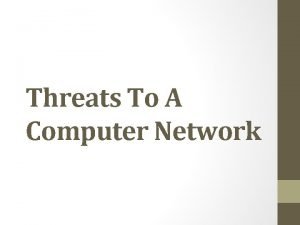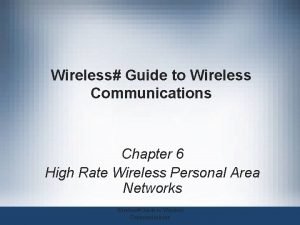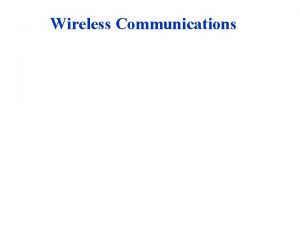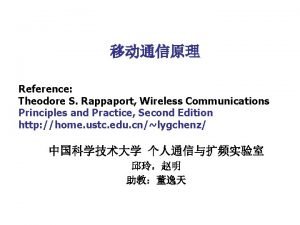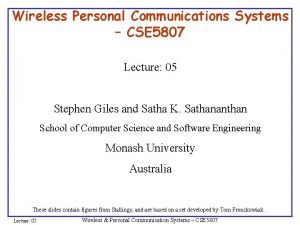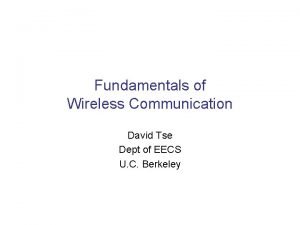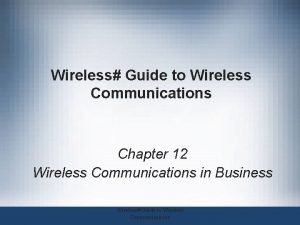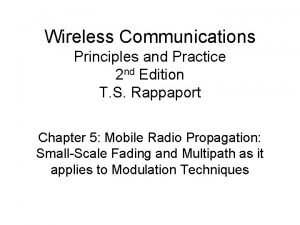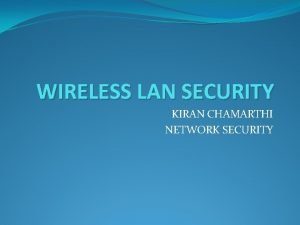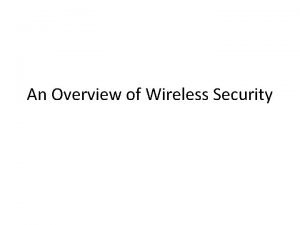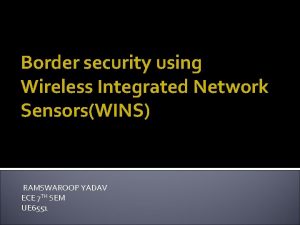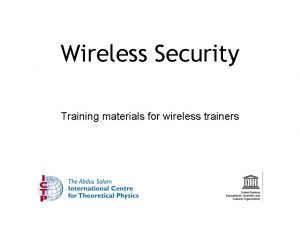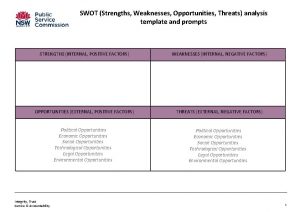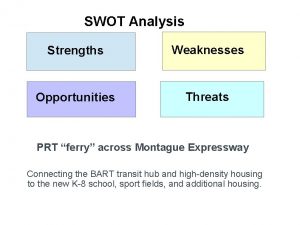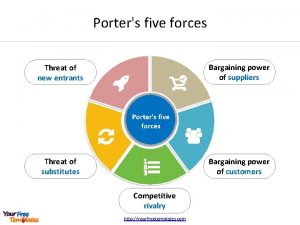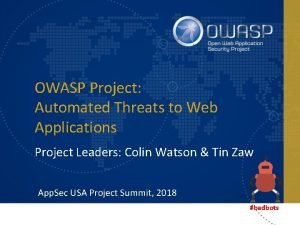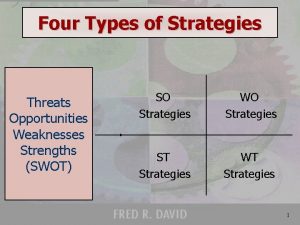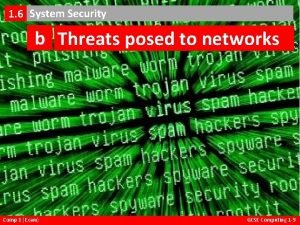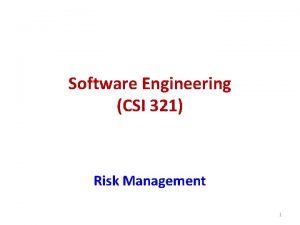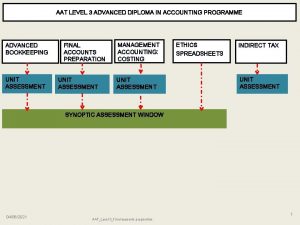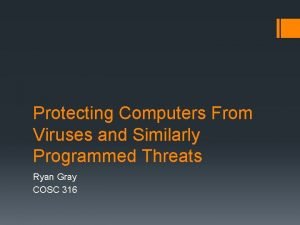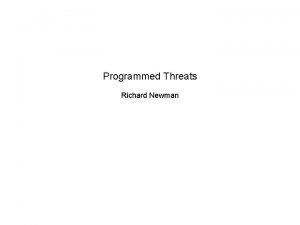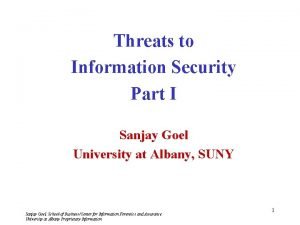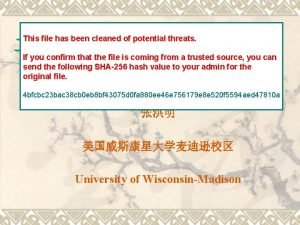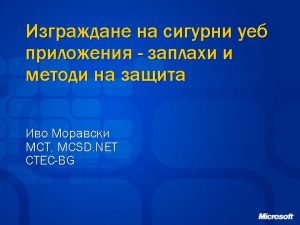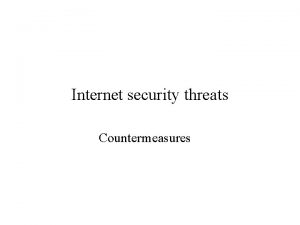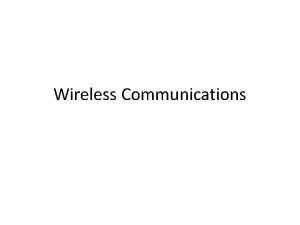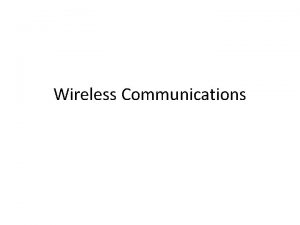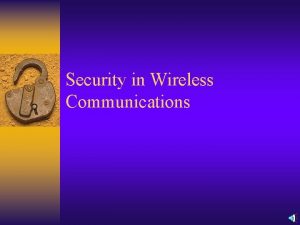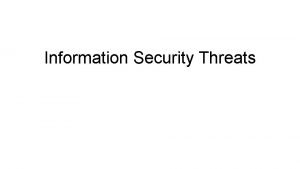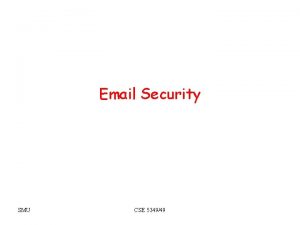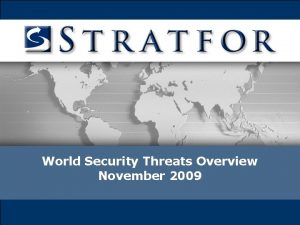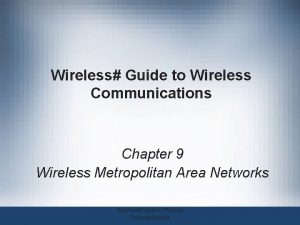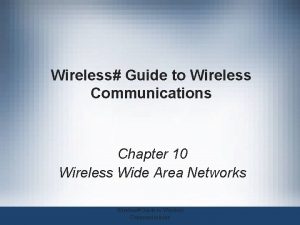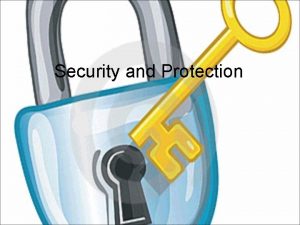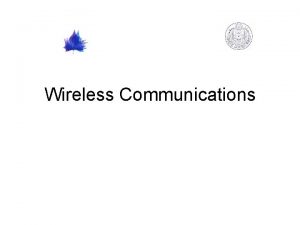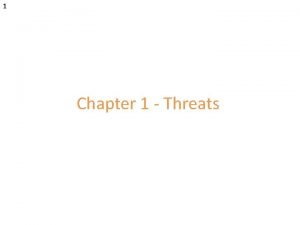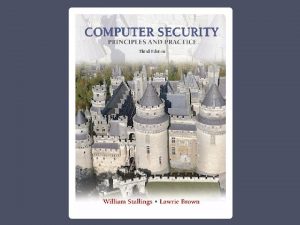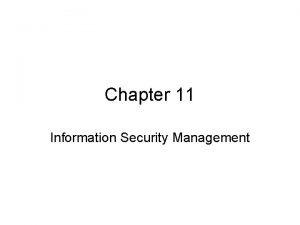Chapter 4 Wireless Security WIRELESS COMMUNICATIONS SPECIFIC THREATS




































![Attacks • Brute force attack acceleration [Moen et al. ‘ 04] – Theoretically possible Attacks • Brute force attack acceleration [Moen et al. ‘ 04] – Theoretically possible](https://slidetodoc.com/presentation_image_h2/83a791e90f58eb85bcb84b773f2a0bb2/image-37.jpg)




















- Slides: 57

Chapter 4 – Wireless Security

WIRELESS COMMUNICATIONS SPECIFIC THREATS

Key terms Attack: A series of steps executed by a malicious individual aiming – to access confidential data – to disrupt the normal operation of a software, piece of equipment, system or network. Attacker: An entity (e. g. , an individual or a process) perpetrating an attack. Threat: A hypothetical case in which an attacker exploits a weakness or a flaw to perpetrate an attack.

Wireless communications threats • Eavesdropping • Unauthorized transmission – Jamming – Denial of service • MAC layer misbehaviour • Address spoofing • Location tracking

RISK ANALYSIS

Key terms Risk: A possibility of the perpetration of an attack. Risk assessment: Evaluation of the level of risk of an attack. According to – potential impact – technical difficulties that must be overcome – motivation of potential attackers. Quantitative risk assessment: – Assignment of a numerical probability to a level of risk. – Based on historical data (objective by nature). Qualitative risk assessment : – Assignment of a symbolic value (e. g. , low, medium or high) to a level of risk. – Relies on the expertise of the people conducting the analysis (subjective by nature). Risk management: Includes – risk assessment, – communication of the risk to the users and – plans for damage control in cases attacks are carried out with success.

Risk assessment: Why? • Wireless security literature has neglected risk assessment – Example: Lack of perspective in the work on wireless malware propagation (issue raised by Zanero, IEEE Security and Privacy, 2009) • Achieve perspective in a predictable & methodological manner! • Deal with the potential of harmful consequences • Decide if a technology is worth using • Continuing process

Wireless Malware Outbreak • Malware running on a router can be used to intercept information • According to Zanero [2009], a malware outbreak in the wireless world is only theoretical and unlikely to occur in practice – difficulty to write a malware for a wide diversity of hardware platforms – at best a small fraction of the routers can be infected – networks of routers being infected by malware would be substantially disrupted, attack would be quickly noticed by network • Unlikely to occur, risk is minor

Risk as a function likelihood and impact, according to ETSI

Impact assessment Minor • Annoyance or reversible consequences • Outages very limited in scope, few users impaired for a short duration February 2009 - Royal Canadian Mounted Police (RCMP) seizes 66 jammers of cellular phone, 911 and emergency service frequencies.

Impact assessment (cont’d) Local residents dealing with open-and-shut case, sort of July 2012 New radio system at sub base fouling up garage door openers. Sondra Tuchman used to open her garage door from halfway down the block. Now she has to get out of her car, stand in front of the door and press the remote. A new radio system operating at the Naval Submarine Base in Groton may be to blame. The communications system is being used at most U. S. military installations to connect military personnel and civilian first responders over a wide area, and it "may interfere with nearby garage door openers in the surrounding community”.

Impact assessment (cont’d) Moderate • Short duration service loss • Outages that are limited in both scope and possible financial losses October 2006 – Woman arrested at her arrival at the Cairo International Airport pregnant with 48 cellular phones.

Impact assessment (cont’d) Significant • Service loss or outages over a long period of time with a large number of users impaired • Possibly accompanied by law violations or substantial financial losses Poland, Lodz 2008 - Schoolboy hacks into city's tram system. Adapted a television remote control so it could change track points. Twelve people were injured in one derailment, and the boy is suspected of having been involved in several similar incidents.

Impact assessment (cont’d) Phony calls clog Des Moines police radio December 2012 A Webster Township man programmed a radio to the Des Moines Police Department's communications frequency and used it to impersonate an officer while calling in nonexistent car crashes and fires, police said. Kevin Grimes, 22, now faces 28 counts of obstructing emergency communications and eight counts of impersonating public officials. The eight impersonation counts come from the multiple alleged calls that forced Des Moines public safety departments to send people, vehicles and equipment to the scene of supposed incidents. .

Likelihood as a function of attacker motivation and technical difficulty

Motivation assessment

Example: Canada's ranking for sensitive information Subcategory Protected C (extremely sensitive) Motivation Impact High Significant Moderate Minor/Moderate Protected B (particularly sensitive ) Protected A (low-sensitive)

Black. Berry messages may be used in Mafia murder case CTVNews. ca, Jan. 2012 Murder of Salvatore Montagna: Raynald Desjardins apprehended by police. . . Blackberry may have given up clues in Montagna murder. . . The police have successfully intercepted PIN messages, encrypted messaging. . .

Eavesdropping Management Messages: Mapping Cellular Networks

Result of Eavesdropping Management Messages: Location Tracking With Cellphones BS 1 BS 2 Time Magazine, March 27, 2006

Risk management actions as a function of impact and likelihood

CONFIDENTIALITY

What is Confidentiality? • The content of a message can be understood only by its source and destination 23

Why is it Challenging? • Interception easiness • Need to maintain backward compatibility • Easiness to work around regulations 24

Interception of traffic HOWTO • Application level – Monitoring or scanning software (e. g. , Kismet) • Frame level – Linux Packet Socket API • Signal level – Software-Defined Radio (SDR) – Documented work: Implantable Medical Device, GSM, Blue. Sniff, RFdump (802. 11, Bluetooth and Zig. Bee)

ENCRYPTION

Encryption • Stream cypher – RC 4/WEP – TKIP • Block-cypher – AES – DES • Quantum encryption

STREAM CYPHER

RC 4 Encryption 29

WEP Encryption 30

WEP Decryption 31

Cracking RC 4 Messages 32

Key Distribution • Default key – 40 or 104 bit symmetric network key • Key-mapping key – 40 or 104 bit symmetric pairwise key • IV (24 bits) + key (40 or 104 bits)=64 or 128 -bit security

Wired Equivalent Privacy (WEP) • Cracking tools and software readily available – IV too short • Well established that WEP is insecure: high risk of eavesdropping • Not an option for Protected B or C traffic

Temporal Key Integrity Protocol (TKIP/WPA) • RC 4 encryption with longer keys

TKIP 36
![Attacks Brute force attack acceleration Moen et al 04 Theoretically possible Attacks • Brute force attack acceleration [Moen et al. ‘ 04] – Theoretically possible](https://slidetodoc.com/presentation_image_h2/83a791e90f58eb85bcb84b773f2a0bb2/image-37.jpg)
Attacks • Brute force attack acceleration [Moen et al. ‘ 04] – Theoretically possible to resolve the 128 -bit temporal key from TKIP RC 4 encrypted frames – Time complexity: O(2105) • Chopchop attack [Beck and Tews ’ 09] – Decrypt the content of an ARP packet, byte by byte – Access points do implement mitigation mechanisms slowing down the attack • Beck-Tews attack – extension of the chop attack • Royal Holloway attack – theoretical attack exploiting RC 4 vulnerabilities • Likely that a general eavesdropping attack on TKIP will eventually succeed • Risk is critical, i. e. , need to monitor the TKIP cracking progress

BLOCK-CYPHER

CCMP/WPA 2 • Advanced Encryption Standard (AES) • 128 -bit keys • Counter Mode with Cipher Block Chaining Message Authentication Code Protocol (CCMP)/802. 11 i • Message Integrity Code (MIC) – MPDU, including header (contains a nonce) • Nonce – Packet number (48 bits), MAC address (48 bits), priority (8 bits)

Counter Mode 40

Attacks • Brute force attack and dictionary attack – can be prevented with good passphrase management • Eavesdropping attack – difficulty is strong, unlikely, risk is minor

QUANTUM ENCRYPTION

Polarization of Photons

Polaroid filter

Encoding Information in photons

Rectification of polarity

Orthogonal vs non-orthogonal polarity • Let us assumed that a rectilinear filter is used to filter a beam of photons. • All rectilinear polarized photons pass through the filter. • Diagonally polarized photons go through as well, but their basis is rectified. • The polarity of every diagonally photon is rectified vertically, with probability 50%, horizontally, with probability 50%. • The rectilinear and diagonal basis are not mutually orthogonal. • Although, vertical and horizontal polarities are mutually orthogonal because there are no possible rectification from one to the other.

Non-cloning theorem • Assuming polarities are not mutually orthogonal. • A photon polarity (quantum state) is disturbed during measurement. • It is impossible to make copies of photons in unknown polarities. • An arbitrary photon polarity cannot be perfectly duplicated.

Free space quantum communication R. Ursin et al. , Entanglement-based quantum communication over 144 km. Nature Physics, 3(7): 481 --486, 2007.

Quantum Key Distribution (QKP) • Aka: BB 84 (Bennet and Brassard 1984), quantum key expansion protocol • Two parties (Alice & Bob) – Insecure photon (quantum) channel – Authenticated classical channel – Share a short key – Can generate random numbers • One adversary (Eve) – Can intercept & resend photons – Can eavesdrop, but not alter classical channel

QKP


AUTHENTICATION

WEP Device Level Authentication

Port-based model

Keys • Pre-Shared KEY (PSK) • Pairwise Master Key (PMK): Long term • Pairwise Transient Key PTK) – Temporal Key (TK): Traffic – Downlink MICHAEL MIC Key – Uplink MICHAEL MIC Key – Group Temporal Key (GTK)

WPA Authentication
 Wireless security threats and vulnerabilities
Wireless security threats and vulnerabilities Wireless security threats
Wireless security threats Wireless security in cryptography and network security
Wireless security in cryptography and network security Cyber security threats and countermeasures
Cyber security threats and countermeasures Ccna security chapter 1
Ccna security chapter 1 Ecommerce security threats
Ecommerce security threats Computer network threats
Computer network threats Privatesecurity
Privatesecurity Guide to wireless communications 4th edition
Guide to wireless communications 4th edition Constrained nodes and constrained networks
Constrained nodes and constrained networks Subsea wireless communications
Subsea wireless communications Theodore s rappaport wireless communications
Theodore s rappaport wireless communications Cse
Cse David tse wireless communications
David tse wireless communications Guide to wireless communications
Guide to wireless communications Wireless communications: principles and practice
Wireless communications: principles and practice Telecommunications the internet and wireless technology
Telecommunications the internet and wireless technology Ssh untar
Ssh untar Density vs specific volume
Density vs specific volume Specific gravity to specific volume
Specific gravity to specific volume Wireless security definition
Wireless security definition Wireless transport layer security
Wireless transport layer security 802-11-wireless-security
802-11-wireless-security Border security using wins
Border security using wins Wireless security training
Wireless security training Major threats to biodiversity
Major threats to biodiversity River animal adaptations
River animal adaptations Threats to biodiversity a case study of hawaiian birds
Threats to biodiversity a case study of hawaiian birds Strength weakness opportunity threat template
Strength weakness opportunity threat template Strengths opportunities threats weaknesses
Strengths opportunities threats weaknesses Threats of new entrants
Threats of new entrants Owasp top 20 automated threats
Owasp top 20 automated threats Face threating
Face threating Types of opportunities
Types of opportunities Folk cultural landscape
Folk cultural landscape Impending danger threats
Impending danger threats New caledonia barrier reef
New caledonia barrier reef School threats examples
School threats examples Malicious attacks threats and vulnerabilities
Malicious attacks threats and vulnerabilities Accounting
Accounting Factbranch
Factbranch Data interception and theft
Data interception and theft Swot analysis of a teacher
Swot analysis of a teacher Swot analysis example for teachers
Swot analysis example for teachers Risk management in software engineering
Risk management in software engineering Risk analysis in software engineering
Risk analysis in software engineering Opportunities and challenges in media
Opportunities and challenges in media Hudhud chants of the ifugao threats
Hudhud chants of the ifugao threats External validity definition
External validity definition Chaparral npp
Chaparral npp Threats to ethical principles aat
Threats to ethical principles aat Why were threats of secession feared
Why were threats of secession feared Types of threats
Types of threats Programmed threats
Programmed threats Programmed threats
Programmed threats Threats to biodiversity
Threats to biodiversity Unintentional threats to information systems
Unintentional threats to information systems This file has been cleaned of potential threats
This file has been cleaned of potential threats
